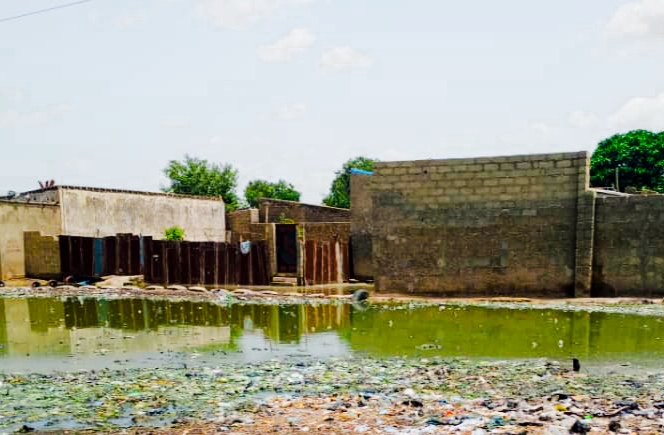State Emergency Management Agency sets up temporary shelters – handing out mosquito nets, blankets, mattresses and food, as well as providing healthcare services – for flood victims in Mainok town.
Hundreds of people have been left homeless after heavy downpours submerged and destroyed mud huts in Mainok town in the Kaga Local Government Area in Nigeria’s northeastern Borno State.
Commuters were left stranded as flash flooding cut off the Maiduguri-Damaturu road.
A heavy downpour started in the early hours of Monday, July 15, and lasted for more than three hours. More rain followed in less than 24 hours.
Barkindo Mohammad Sa’idu, the director-general of Borno’s State Emergency Management Agency (SEMA), told RNI that a team from the northeast zonal office was sent to Mainok town on Tuesday, July 16, to assess the damage caused by flash flooding.
“As part of the emergency response, the SEMA set up temporary shelters for the flood victims. We handed out mosquito nets, blankets and mattresses. We also set up a facility to provide emergency healthcare services.”
He said flooding had displaced hundreds of people, mainly women and children.
Emergency workers were assessing the situation to identify areas where intervention was possible to provide support to those affected, he said.
“We are assessing the impact of the flooding to try to ensure that aid reaches those who need it most. We are doing everything possible to alleviate the suffering of displaced individuals and to support the community’s recovery from this natural disaster.
“Right now, we do not have the exact number of individuals or households affected. We have provided temporary shelters and handed out mosquito nets, blankets and mattresses, as well as food, to the flood victims.”
Residents of Mainok town told RNI that the heavy downpour started at about 4am on Monday. Lashing rain and strong wind continued until about 8am. Another downpour followed in less than 24 hours.
Malum Modu Mainok said nearly 300 mud houses were submerged and destroyed, leaving many homeless with no place to go.
“We had to flee to neighbouring communities.”
“I and my family – with scores of people – are taking refuge in schools and empty buildings that are still under construction,” said Bana Goni Modu. “Some people are still stranded and have no place to go. There are not enough temporary shelters and we do not have even the basic amenities.”
Mainok town residents said there had been widespread damage to properties. Homes and farmlands had been submerged.
One resident, who identified herself only as Falmata, described the flash flood as arriving “like a thief in the night”.
With her children walking beside her and balancing a large bag containing belongings on her head, she said her home was flooded and she had no place to go.
“My farmland was also flooded and crops washed away.”
A commuter, who gave his name as Sunday, said the river had broken its banks, swamping and cutting off the Maiduguri-Damaturu road.
“The water has begun to subside but travellers were stranded for hours.”
He said he had spent the night on his farm and was trying to return to Maiduguri.
“The road was flooded and there was no way vehicles could pass. Many vehicles that were on the way to Maiduguri, Kano and other places were stuck. The road looked like a river.”
Sunday said he did not live in Mainok but residents had told him that the town need a better drainage system.
“They told me that whenever there are heavy downpours and the river is full, the water swamps their houses. This leaves them vulnerable to flooding and they have to leave their homes.”
Dr Iziaq Salako, the Minister of State for Environment, warned that 94 towns were at risk of a five-day flooding beginning Tuesday, July 16, and ending on July 20.
He said it was likely that 20 states, including the Federal Capital Territory, would experience heavy rainfalls that could lead to floods.
Five out of the six states in the northeast of Nigeria – Borno, Yobe, Adamawa, Bauchi and Taraba – would be affected.
Zubaida Umar, the director-general of the National Emergency Management Agency (NEMA), said flooding in Nigeria was a multifaceted issue, driven by both natural and human-induced factors.
The primary natural cause was heavy rainfall, which overwhelmed drainage systems, particularly in urban areas.
She said inadequate planning and poor drainage systems contributed to flooding.
“Many towns and cities have outdated or poorly maintained drainage systems, which are often clogged with waste, preventing the efficient flow of water.
“Deforestation and land degradation also play crucial roles, reducing the land’s ability to absorb water, leading to surface runoff that causes floods.”
Umar said as far as possible, NEMA provided early warning alerts to vulnerable communities, “allowing for better preparation and quicker response times, potentially saving lives and reducing damage”.
At the beginning of every rainy season, NEMA intensified community awareness campaigns to educate residents in flood-prone areas about the risks and preventive measures they could take.
She emphasised the importance of maintaining clear drainage systems and proper waste disposal.
SHETTIMA LAWAN MONGUNO









